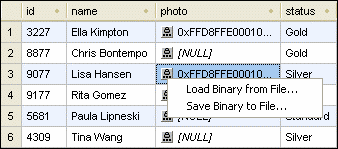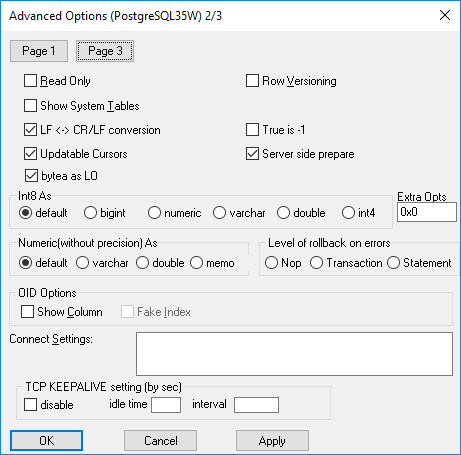Editing Binary Columns
Binary content can be stored in databases using the following data types:
Oracle | BLOB, LONG RAW, RAW, BFILE |
MS SQL Server | binary, varbinary, image |
MS Access | BINARY, IMAGE |
MySQL | binary, tinyblob, varbinary, blob, mediumblob, longblob |
IBM DB2 | BLOB |
IBM DB2 for i | BLOB, BINARY LARGE OBJECT, BINARY, VARBINARY |
SQLite | BLOB |
Sybase | binary, varbinary, image |
PostgreSQL | byte array |
In DatabaseSpy you can choose to (i) save binary content from the result grid to a file, or (ii) load binary content from a file and store it in the database. The respective menu entries are available when you click the ![]() button inside a data cell of the result grid.
button inside a data cell of the result grid.

DatabaseSpy presents the standard Windows Open, respectively the Save As, dialog box for this purpose. Binary content can be saved to the following formats BIN, BMP, JPG, PNG, MP3, AVI, and PDF.
To change the binary content of a database data cell:
1.Click the Browse  button inside the data cell you want to edit.
button inside the data cell you want to edit.
2.From the menu that appears, select Load Binary from File... or Save Binary to File....
3.Do one of the following:
•In the Open dialog box, browse to the desired binary file and click Open.
•In the Save As dialog box, select the folder where you want to save the binary file, enter a name for the file, and click Save.
4.To commit your changes to the database, click the  button in the Result window toolbar.
button in the Result window toolbar.
Note: MS Access does not support the loading of a binary file in a binary column.
Note: When connecting to PostgreSQL through the ODBC driver, select the bytea as LO check box on the second page of the advanced data source options of the PostgreSQL driver settings.
